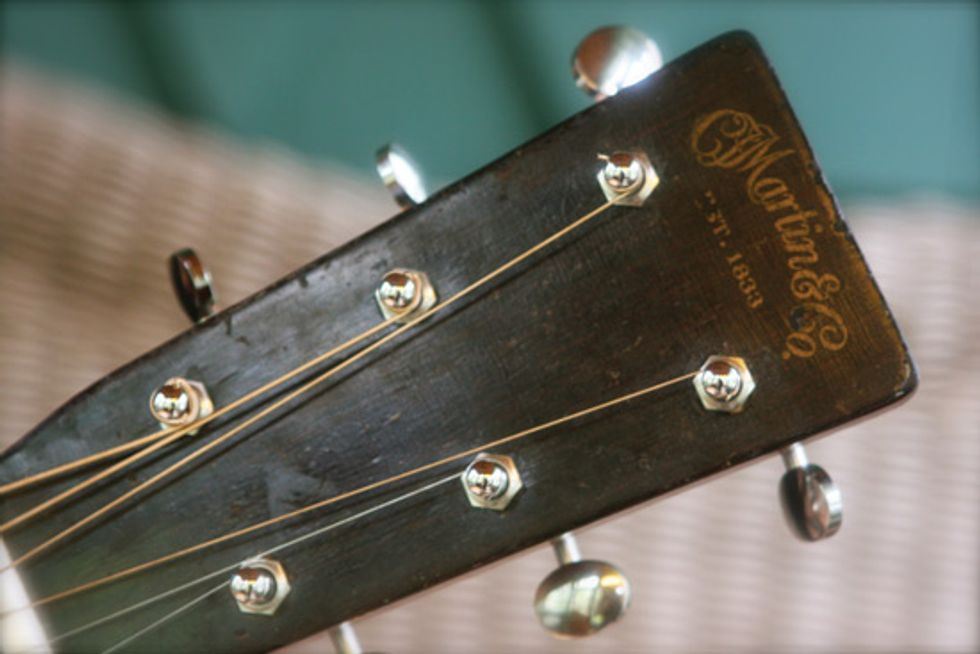Addressing the differences between playing live and performing in the studio
This month, were going to address some of
the differences between playing live and performing in the studio. When you’re onstage
and the energy level is amped-up (no pun
intended), the tendency is to play a few more
notes than you may need to. It’s fun and
exciting to show your chops, because, after
all, that’s what all those hours of practice
were about. But when the tape is rolling and
the red light goes on, it might be best to
minimize your approach.

The quality of instrument—like this 1932 Martin 0-18—will often dictate how you approach a track.
There’s a big difference between playing, and playing what’s right. It usually comes from years of experience, but it also comes from really listening—listening closely to the melody, the chord structures, the arrangement, the bass, and so on. Think about the orchestration of the song—will your first position chords carry too much bottom and cloud up the low end of the mix? Do you even need to play the root/bass notes of the chords? Consider moving them up a position, or use a capo to change things up. Think beyond only your part. Think about what it really needs as a song.
Also, if you’re cutting a track for another artist, it’s important to avoid any attachment to your part. That doesn’t mean you shouldn’t be proud of your work, but don’t get stuck on it. This goes for anybody: drummers, bass players, etc. It’s vital for us guitarists to think of what we’re playing as a single Lego block in a toy house. It should be attachable and detachable, in the scope of editing.
I’ve had many stressful moments in studio situations where the guitarist I’m tracking gets offended if his/her parts are not used. It’s the same if his/her parts are cut up to fit better. Sure, I always prefer to recut and make them play it again, but that’s not always possible (especially after they are gone). Sometimes, their attitude is enough to make the art- ist compromise. It can also make for some uncomfortable moments. That’s not cool.
When I produce, I will often tell a new/unknown guitarist to have no attachment to what they are about to cut. That lets them know that they need to let go of it once it’s recorded. Humor often works at this point in a session, and I’ll say, “play whatever you want, as long as it’s exactly what I need.” Of course I’m kidding, but I’m also not. The point is to get them to not feel restricted, but make sure that what they’re about to give me makes sense.
Another interesting aspect about playing in the studio is that your instrument will often dictate the part. I’ve found that the higher quality the guitar, the less that needs to be played to sound good. With electric parts, that also applies to the amp. Of course, the player’s touch is paramount, as is often the mic/preamp combo, but often a fine instrument can breathe in a song better than one that’s just OK.
Just last week for example, I was cutting some TV cues with guitarist/producer Scott E. Moore. He had just picked up a 1932 Martin 0-18. We put a single Earthworks QTC-1 on it with an Anthony DiMaria/PreSonus ADL 600 preamp, and it simply sang. There are guitars, and then there are guitars. The light, airy clarity of this instrument dictated the parts we laid down.
On several cuts, we stripped back the melody to take advantage of the sound of the instrument. So it was not only the musicality of the melody, but the simplicity and beauty of the single notes. They just cut through. Sure, you could play the same notes on other acoustics, but it wouldn’t be the same. That’s not to say you need a vintage Martin to cut all acoustic parts—you certainly don’t. It’s just that you should take the sound of the instrument into consideration from a production point of view. We all know some guitars simply sound better than others. That’s especially true when magnified by microphones.
So next time you’re getting ready to cut some studio tracks, take a step back for a moment. Think about what guitar is the right call. It may not be the same one you gig with all the time. Next, think about the part and the position that you’ll be playing it at. Take the time to make sure it fits both the production and the arrangement of the song. And, of course, try to use the best mic you possibly can. Then, after all of that, forget about everything and just play!
Rich Tozzoli is a Grammy-nominated engineer and mixer who has worked with artists ranging from Al DiMeola to David Bowie. A life-long guitarist, he’s also the author of Pro Tools Surround Sound Mixing and composes for the likes of Fox NFL, Discovery Channel, Nickelodeon and HBO.


